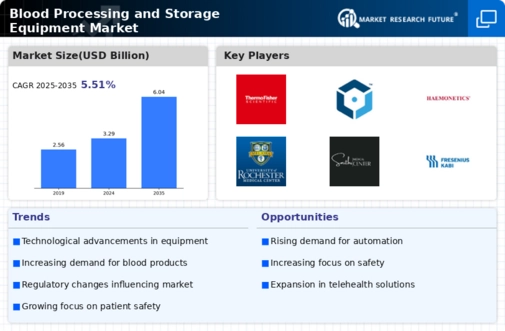Market Growth Projections
The Global Blood Processing and Storage Equipment Market Industry is projected to experience robust growth, with estimates indicating a rise from 3.29 USD Billion in 2024 to 6.04 USD Billion by 2035. This growth trajectory suggests a compound annual growth rate of 5.68% from 2025 to 2035, reflecting the increasing investments in healthcare infrastructure and technological advancements. The market dynamics are shaped by various factors, including rising demand for blood components, regulatory compliance, and public awareness of blood donation. These elements collectively contribute to a favorable environment for market expansion, indicating a promising future for stakeholders in the blood processing and storage sector.
Rising Awareness of Blood Donation
The Global Blood Processing and Storage Equipment Market Industry benefits from increasing public awareness regarding the importance of blood donation. Campaigns aimed at encouraging voluntary blood donations are gaining traction, leading to higher collection rates. As more individuals recognize the critical role of blood in medical treatments, the demand for efficient processing and storage solutions escalates. Blood banks are thus compelled to upgrade their equipment to handle the increased volume of donations effectively. This trend is anticipated to further stimulate market growth, as facilities seek to optimize their operations and ensure the availability of safe blood products for patients in need.
Expansion of Healthcare Infrastructure
The expansion of healthcare infrastructure globally is a key driver for the Global Blood Processing and Storage Equipment Market Industry. As countries invest in healthcare facilities, the demand for blood processing and storage equipment rises correspondingly. New hospitals and blood banks are being established, particularly in developing regions, to enhance access to medical services. This growth is expected to create substantial opportunities for equipment manufacturers, as they supply advanced solutions to meet the needs of expanding healthcare systems. The increasing number of healthcare facilities is likely to contribute to the overall market growth, reinforcing the importance of reliable blood processing and storage solutions.
Increasing Demand for Blood Components
The Global Blood Processing and Storage Equipment Market Industry is experiencing heightened demand for blood components, driven by the rising prevalence of chronic diseases and surgical procedures. As healthcare systems globally prioritize efficient blood management, the need for advanced processing and storage solutions becomes paramount. In 2024, the market is projected to reach 3.29 USD Billion, reflecting a growing recognition of the importance of safe blood supply chains. This trend is likely to continue, as hospitals and blood banks invest in state-of-the-art equipment to enhance their operational capabilities, ensuring that they can meet the increasing demand for blood products.
Regulatory Compliance and Safety Standards
The Global Blood Processing and Storage Equipment Market Industry is heavily influenced by stringent regulatory compliance and safety standards imposed by health authorities worldwide. These regulations necessitate the use of high-quality equipment that meets specific safety criteria, thereby driving market growth. Facilities are increasingly required to adopt advanced technologies to ensure the safety and efficacy of blood products. As a result, investments in compliant equipment are expected to rise, contributing to a compound annual growth rate of 5.68% from 2025 to 2035. This focus on compliance not only enhances patient safety but also reinforces the integrity of blood supply chains.
Technological Advancements in Blood Processing
Technological innovations are transforming the Global Blood Processing and Storage Equipment Market Industry, with advancements in automation, data management, and storage solutions. These innovations enhance the efficiency and safety of blood processing, allowing for better tracking and management of blood products. For instance, automated blood collection systems and advanced refrigeration technologies are becoming standard in many facilities. As a result, the market is expected to grow significantly, potentially reaching 6.04 USD Billion by 2035. The integration of smart technologies not only improves operational efficiency but also ensures compliance with stringent regulatory standards, thereby fostering trust in blood supply systems.



















